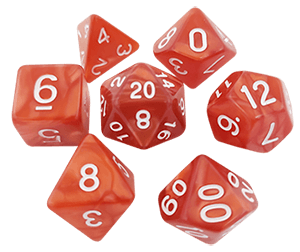Starting a Collection
Before starting a TRPG materials collection, librarians should ensure their libraries have the appropriate policies in place for collection development, materials selection, and handling of any challenges to library materials.
The Investment
Librarians often have to put forth little investment when collecting TRPG materials. Core rulebooks are the bare minimum required to create a collection. Some print editions come in boxed sets complete with rule books and game pieces, such as cards, dice, miniatures, and counters.

Set of polyhedral dice, including d4, d6, d8, d10, d%, d12, and d20.
Librarians should also consider providing paper and blank character sheets, as well as d6 or polyhedral dice sets for patron use. Gameplay may be upgraded with the use of miniatures, maps, and dry-erase grid mats – though these tend to be more costly additions.
Collections Budget
- Small libraries (up to 5,000 patrons) should set aside a budget of $200.
- Medium-sized libraries (up to 150,000 patrons) should set aside a budget of $1,000.
- Large-sized libraries (>150,000 patrons) should set aside a budget of $5,000 or more.
Spatial Considerations
TRPG materials should be placed in a prominent spot within the library. These materials should be visible to patrons and attract their attention. To attract patron attention, librarians are encouraged to display materials so the cover art can entice patrons to pick up the materials.
Circulating TRPG materials may be displayed in certain areas of the library where they will receive the most attention, such as near young adult and teen collections. Non-circulating materials, or materials that contain small pieces, such as boxed sets, should be kept at the circulation desk to prevent theft or vandalism.
Like graphic novels, TRPG books may experience heavier circulation, and as a result, may experience a shorter shelf life. This should not deter librarians from collecting TRPGs as these materials are worth the initial investment and replacement if patrons are interested and frequently borrow them.
Acquisition Considerations
Games should be collected from a variety of different genres, such as fantasy, science-fiction, and horror.
Generic TRPG systems may be considered for their utility, as they provide essential rules and may be played with any setting or genre. A major advantage of generic TRPG systems is that they only require one set of rules to learn for all settings.
Free and quick-start PDFs are a great way to introduce a game to the collection. Free RPGs are advantageous as they often ignore polyhedral dice sets and base their game mechanics on pools of d6 dice, which are inexpensive and easy to find.
When selecting TRPGs with multiple editions, such as Dungeons & Dragons, be aware of compatibility issues between editions. Many game publishers will release new editions of a game to entice players to purchase the game system again. Older editions soon become out-of-print and difficult to purchase, as well as incompatible with newer editions.
Supplementary Materials
Some TRPGs may require additional materials, such as further rulebooks, settings, and official adventures in order for the game to run properly. Oftentimes, these additional supplements may be helpful, but often optional.
- Example: Dungeons & Dragons may be played using only the Player’s Handbook, but if a library collection includes additional rulebooks, such as the Dungeon Master’s Guide, gameplay becomes a richer experience.
While many GMs create their own adventures, numerous game publishers provide pre-made adventures that are useful for players and GMs new to a game.
- Example: when a new starter edition of Dungeons & Dragons is released, its publisher also includes an introductory adventure, such as “The Lost Mines of Phandelver” and “Dragon of Icespire Peak”. These pre-made adventures come complete with a setting, maps, environmental descriptions, non-player characters (NPCs), and statistics for enemies.
Engagement with Library Collection
Other considerations for engaging patrons with TRPG collections include creating read-a-like lists of book titles pertaining to TRPGs and purchasing materials that are linked to popular culture and established fandoms.
By collecting games that have been adapted to fit popular fandom settings, TRPG collections can further encourage interaction with these materials. Popular fandoms that also have their own TRPG include:
- Star Trek: The Role Playing Game.
- Star Wars: Edge of the Empire.
- Doctor Who: Adventures in Time and Space.
- Firefly Role-Playing Game.
Keeping Up To Date
Prior to purchasing TRPG titles, librarians should do their homework to ensure game titles are appropriate and will be used by the anticipated patrons.
Local RPG groups are a great reference as they are able to provide information about the kinds of games that exist. These groups may also become effective partners for promoting library TRPG programs, as well as an effective recruitment tool to locate volunteers to referee games.
Email newsletters are a great way to stay recent about upcoming RPG games and news. Review sites could also be consulted, such as RPG Geek or RPG.net, to develop an understanding of different TRPGs and their settings, play styles, requirements, and systems.
Friendly local game stores (FLGS) also make great resources for librarians. Similar to RPG groups, employees and local game store owners are usually willing to answer any questions a librarian may have about any particular TRPG. They can make an ideal partner for promotion and volunteer recruitment. Not only are local game stores ideal for purchasing TRPGs, they will often allow librarians to test out a game prior to purchase.
